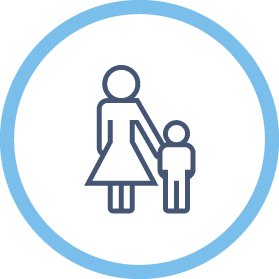Paid Family Leave: Information for Workers
On July 1, 2020, the District began administering taxes from all private sector employers, located in the District, to fund the Paid Family Leave benefit. All DC workers have access to the benefit, even if additional leave benefits are provided by your employer.
It makes a better work environment. Morale can be very low, and it makes you more willing to stay with a particular employer because they have that benefit and support you as a worker. -DC Worker
What does Paid Family Leave mean for DC workers?
Workers want to live in a city and community where they–and their priorities–are valued and respected. The District of Columbia is implementing Paid Family Leave so workers don’t have to choose between family and job security in a time of need.
Most individuals will face situations that require leave, such as caring for a family member or welcoming a new child. Paid Family Leave ensures that all individuals, regardless of their job, are able to access this valuable benefit. Paid Family Leave also protects workers against retaliation or discrimination for taking leave to care for themselves or family members.
How much leave does Paid Family Leave provide?
The Paid Leave Act provides up to:
-
- 2 weeks prenatal leave
- 12 weeks to bond with a new child.
- 12 weeks to care for a family member with a serious health condition.
- 12 weeks to care for your own serious health condition.
Who is eligible for Paid Family Leave?
You are eligible for Paid Family Leave benefits if you:
-
- Are a covered worker in DC. Generally, eligible workers spend a majority of their time working the District. Your employer must report your wages to DC for the purposes of unemployment insurance for you to be eligible for paid family leave. Ask your employer if you are unsure about whether you are covered by the program—your employer is required to tell you.
- Are self-employed and have opted into the Paid Family Leave program. If you are not a covered worker but are self-employed, you may be eligible if you earned self-employment income for work performed more than 50% of the time in DC and opted in to the program.
- Are employed when you apply for the benefit. You must be currently employed to apply for paid family leave benefits. In addition, your wages must have been reported by your covered employer in order for you to be eligible for the benefit. If you are receiving unemployment compensation benefits, you are not eligible for Paid Family Leave.
- Experienced a qualifying event. You must have already experienced a qualifying event in order to apply for paid family leave benefits. Qualifying events include:
- Having a baby or welcoming a new child into your household
- Experiencing or being diagnosed with a serious health condition
- Having a family member who experienced or was diagnosed with a serious health condition
- Becoming pregnant
How can I calculate my Paid Family Leave benefits?
Potential Impact of Paid Family Leave

Keep Women Working
Paid Family Leave benefits all workers, but is especially critical for women. Women staying in the workforce increases the economic stability of families and contributes to overall economic growth and productivity.

Prevent Lost Wages
Without Paid Family Leave, women are discouraged from staying in the workforce so they can care for family members. As a result, they can lose an estimated $274,044 in lifetime wages, according to a study by the MetLife Mature Market Institute.

Support Working Mothers
New mothers who take Paid Family Leave around the birth of a child are more likely to stay in the workforce than those who do not.
